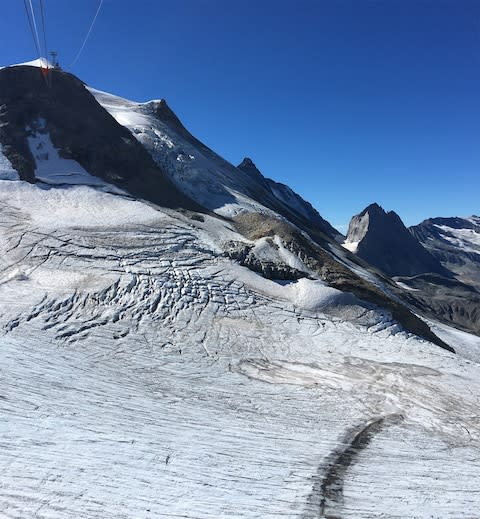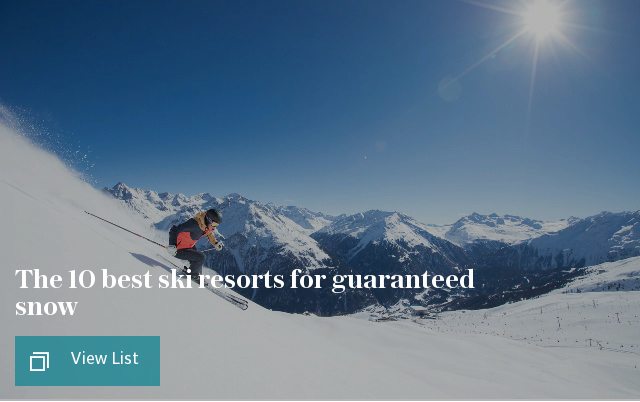Where's the snow? Warmer weather could spell the end for pre-season glacier skiing

As much as we all loved the long hot summer both in the UK and across the continent, the effect of the prolonged warm weather is presenting challenges for the upcoming ski season.
The summer’s hot weather has been followed by a dry autumn in Alpine areas, meaning high-altitude glaciers have missed out on the all-important first layers of snow, which form a foundation for winter pistes. Autumn snow usually allows glacial resorts to open as early as October for half-term skiing and snowboarding and pre-season training camps.
However, a recent report by weather expert Fraser Wilkin from weathertoski.com has highlighted the concerning condition of one of France’s most popular glaciers, in Les Deux Alpes. The resort has announced, for the second year in a row, that its glacier, which sits at 3,600m, will not open for autumn skiing.
“Les Deux Alpes has the largest lift-served glacier in the Alps. It has traditionally opened every half-term but hasn’t managed to do so for two years due to poor snow,” said Wilkin.
The resort will be open for mountain biking and hiking from October 27 to November 4, while skiers and snowboarders will have to wait until December 1, when the ski area opens fully, to access the pistes.
Webcam images of the glacier show the bare bones of the pistes, with a lot of grey rock still exposed.

“The glacier is in good condition, but there is no fresh snow on the top as it hasn't snowed. This is why the resort thinks it is better not open to skiers this autumn and preserve the glacier,” said a representative from Les Deux Alpes.
“The resort has decided not to open the glacier for skiing this autumn as they feel the conditions are not good enough after an exceptionally hot summer and autumn.”
This disappointing news comes after the glacier was open all summer for skiing and snowboarding, with skiers relishing the excellent conditions left from last winter, and continued snowfall in May and June.
I found similarly concerning conditions when I visited Tignes at the end of September. The popular French resort was due to open its Grand Motte glacier the day after my visit on the 28th, but as I stood on top of the world’s largest open-air cable car (the purpose of my visit), travelling to the top of the glacier at 3,456m, crevasses and rocks were still on show on the slopes below, and indeed the resort had to postpone its opening until this Wednesday.

It has now been able to open one intermediate piste and some training areas, thanks to a small amount of high-altitude snowfall, enabling the piste-grooming team to prepare the slopes.
Tignes is not permitted to have a snow-making operation on the glacier, because of its position in the Vanoise National Park, so has wait for new natural snow to fall. Grooming teams also spread snow preserved from the previous winter over the slopes.
“This time last year the glaciers already had good snow. This year it’s not so good, especially in France where not only has Les Deux Alpes cancelled it’s October half-term opening, Tignes only opened a limited area on Wednesday,” said Wilkin.
Phil Smith from UK ski school Snoworks was in resort when the slopes opened in Tignes. “The changing weather patterns mean there's no real predictability on snowfall from year to year,” he said. “You can have two metres of snow one autumn and no snowfall at all the next.”
“Tignes is now open and conditions are excellent - our courses started on Wednesday as soon as it opened,” added Smith.

The future of glaciers and the impact of global warming in the mountains is already a concern for the ski industry.
Statistics provided by Protect Our Winters, a charity campaigning for increased awareness of the risks posed to glaciers and winter conditions by man-made emissions, predict that there could be a 40 to 80 per cent reduction in the amount of snow in the Alps by 2050, with areas below 1,500m seeing a significant decrease. Alpine glaciers lost about half their volume of snow between 1850 and 1975, a 125 year period, however another 25 per cent was lost in just 25 years between 1975 and 2000 – an alarming acceleration.
French resorts have borne the brunt of the damage caused by this year’s hot summer. In the eastern Alps, in Austria and Switzerland, the glaciers are in a lot better shape.
“Austrian glaciers are generally more snow-sure in the autumn, with Hintertux, which is open 365 days a year, usually the best of all,” said Wilkin.
A post shared by Hintertux Glacier - Tirol (@hintertuxergletscher) on Oct 19, 2018 at 12:40am PDT
The Hintertux glacier in Austria is currently offering the most skiable terrain in the Alps, with 21km of pistes open. The snow depth is at 45cm and over a metre of new snow is predicted to fall in the next seven days. Elsewhere in the country glaciers are open in Stubai, Kaprun, Pitztal, Kaunertal, Mölltal and Sölden.
“Other Alpine glaciers are generally looking a bit better but not great. A shockingly hot summer undid all the good work from last winter’s massive snowfalls,” said Wilkin.
In Switzerland, the glaciers in Saas-Fee and Zermatt are open for skiing; in Italy Val Senales and Passo Stelvio are open.

The recent news from the Alps is in contrast to headlines at the height of last season, when many areas saw record amounts of snowfall. Once the season had ended resorts began snow-farming, a process that preserves snow under layers of sawdust and reflective tarpaulin, so it can be used at the start of the next winter.
Resorts across the world are being proactive in combatting the effects of climate change. In recent years scientists in Switzerland and Italy have worked on methods of preserving Alpine glaciers to stop them from melting. This winter will see an American ski resort become the first in the world to switch all its energy consumption to solar, carbon-free, power. In 2016 it was reported that Tignes is planning to build an indoor snow centre at 2,000m, and last winter ski giant Vail Resorts pledged to achieve zero carbon emissions across all its resorts by 2030.


